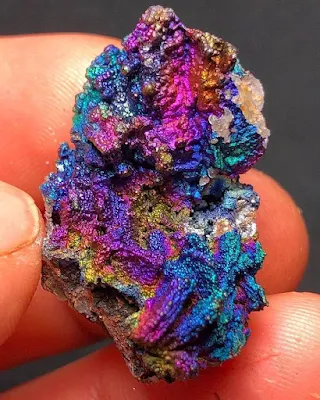Rainbow Hematite, with its enchanting play of colors and metallic allure, is a captivating variety of the common mineral hematite. In this article, we'll delve into the fascinating world of rainbow hematite, exploring its formation, varieties, physical properties, and where to find this mesmerizing gem.
Formation of Rainbow hematite
Fantastic Rainbow Hematite stalactite from the Skittles Pocket, Graves Mountain, Georgia.
Photo copyright © Natalis Gems
Rainbow hematite forms through a captivating process that involves the alignment of microscopic hematite platelets in parallel layers. This unique arrangement results in the iridescence that gives rainbow hematite its name. The thin layers interact with light waves, creating a stunning display of colors reminiscent of a rainbow. Let's delve into an overview of how this captivating gem comes into existence and where it can be discovered
Hydrothermal Processes
One common mode of formation for rainbow hematite is through hydrothermal processes. Hot fluids rich in iron and minerals percolate through rocks, depositing hematite as they cool and react with the surrounding geological features. The iridescent layer on rainbow hematite's surface may be influenced by specific conditions during this hydrothermal deposition.
Weathering and Alteration
Hematite can also form as a result of weathering and alteration of other iron-rich minerals, such as magnetite or pyrite. In some cases, these weathering processes can lead to the development of iridescent surface coatings on hematite.
Varieties and Types
While rainbow hematite is renowned for its iridescence, hematite itself comes in various colors, including silver, black, and steel gray. Rainbow hematite, with its surface play of colors, is a standout variety that has found popularity in the world of jewelry and decorative items.
Physical Properties
- Color: Vibrant, varied hues create a distinctive iridescence in rainbow hematite, setting it apart from other hematite types.
- Luster: Exhibits a metallic sheen, enhancing its visual appeal and adding depth to its appearance.
- Transparency: Opaque nature; thin layers responsible for iridescence limit light passage.
- Hardness: Rates 5.5-6.5 on Mohs scale, making it durable and suitable for diverse applications, including jewelry.
- Crystal System: Trigonal crystalline structure contributes to unique physical properties.
- Chemical Composition: Iron oxide (Fe2O3) defines its metallic appearance, with impurities influencing rainbow hematite's colors.
- Density: Relatively dense composition provides a solid feel.
- Fracture: Displays a conchoidal fracture, breaking with smooth, curved surfaces.
- Cleavage: Poor to absent cleavage, leading to fracture instead.
- Luminescence: Not known for strong luminescence, but vibrant colors under natural light enhance its allure.
Yes this is real!!! Wild natural rainbow pattern on this Quartz crystal tip. The iridescent hematite thickly coated this crystal making for wonderful colors! 🌈 This location is called Graves Mtn, located in Georgia. They are open to public twice per year. You can find these sometimes just weathers out long the surface but mostly by digging into the walls.
Where to Find Rainbow hematite
Rainbow hematite can be found in various locations worldwide. Notable deposits include Brazil, Mexico, and the United States. Mines and geological formations rich in iron ore are potential sources for discovering this captivating gem.
A rare, super vivid rainbow Hematite on Quartz, or ''Turgite'' specimen from Thailand
Photo Copyright © Anatoly Bitny
Uses of Rainbow hematite
- Jewelry: Rainbow hematite's vibrant colors make it a popular choice for jewelry, including beads, pendants, and cabochons.
- Decorative Items: Its unique visual appeal makes rainbow hematite a favored material for ornamental carvings, sculptures, and decorative pieces.
- Metaphysical Purposes: In metaphysical beliefs, hematite is associated with grounding and protection. Some believe rainbow hematite enhances these properties with its colorful display.
- Education and Collection: Rainbow hematite specimens are valued by collectors and educational institutions for their unique characteristics, contributing to the study of mineralogy.
Here is a Beautiful Rainbow Hematite Specimen from Brazil. This Hematite has Phenomenal colors.
Photo Copyright WestCoastMinerals
Here is an incredible 2.5 inch Rainbow Hematite stalactite I collected at Graves Mountain in Georgia.
Photo Copyright © Natalis Gems
In the world of minerals, rainbow hematite stands out as a true gem, captivating observers with its iridescence and metallic charm. Understanding its formation, varieties, and physical properties enhances our appreciation for this mesmerizing creation of nature. Whether adorning jewelry or dazzling collectors, rainbow hematite continues to be a shining star in Earth's treasure trove.
Tags:
Hematite







